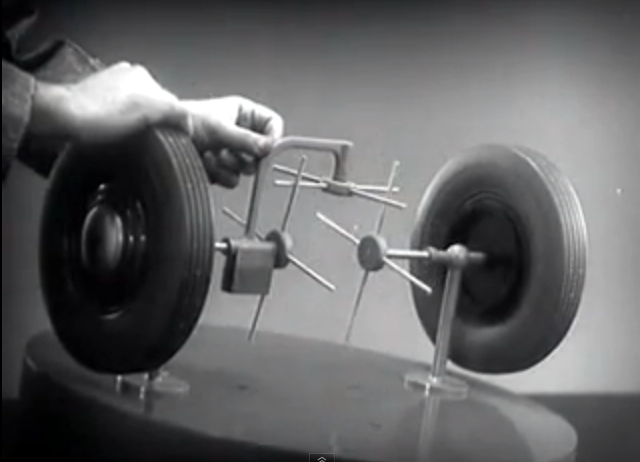Any video that starts off with two minutes of motorcycle formation riding has got to be good. If the grainy black and white video didn’t tip you off that this was made in a different time the helmetless riders standing on the seats of moving motorcycles certainly would have. But there is a purpose to this exposition. A single line of motorcycles riding shoulder to shoulder as they go around a curve illustrates why a differential is necessary and soon after you’ll find out how one works.
Two wheels mounted on one axle need to turn at different speeds as a vehicle goes around a corner or one of the wheels must slip to accommodate the speed difference. The differential is necessary to allow for these different turning rates while still letting both wheels connect to the power train. We were surprised to learn from the video after the break that early automobiles got around this issues by powering only one of the four wheels.
This instructional video is a prefect compliment to the fluid coupling video we saw in the last installment of Retrotechtacular.
[Thanks Matt via Auto Week]
















Wow, this was the best explanation for differentials I’ve ever seen
I thought so, too. I mean, I knew the purpose a differential served but it was always that big sealed lump in the middle of the axle where spinny geary type things happened, but I really didn’t grasp HOW it did it’s magic. This was a great video
if you would like a very easy to the eyes layout of a differential I would say to take a look at the one by vex robotics in this kit, the image shows the main section and the gears next to it pretty well
http://www.vexrobotics.com/276-2184.html
Yeah, these are great. +1
I’ve seen this before but this is absolutely beautiful in simplicity of explaining how a differential works
Not all differentials use three bevel gears like that. The Austin 7 uses six straight cut gears (acting as three pairs across the diff) inside the diff carrier meshing with straight spur gears on the ends of the axle half shafts. Took me a while to get my head around it! That arrangement allows you to do an interesting thing if you break a half shaft which will cause you to lose drive as all the power then goes into the broken side which will spin uselessly. You basically remove the broken sides hub and shove the broken half shaft into the diff until the spur gear meshes with the three gears on the opposite side of the diff. Then you use a wheel nut as a spacer inside the axle tube and reattach the hub on the broken side. This will lock the diff up and transmit power to the unbroken side allowing you to limp home with one wheel drive!
Almost impossible to describe unless you see one.
Well obviously they’re only talking about the classic open diff, the simplest and most common one. There are many types of differentials and far more implementations of each type. Incidentally, it uses four bevel gears here.
Yes, sorry, that was my meaning. There are different types. I was surprised when I opened mine up to find it wasn’t the classic style.
I remember watching this video at uni. Have never seen a better explanation.
want to know how a diff works….buy a landrover!
Never a truer word spoken!
I’ve gone through a Series III, 90″ (I REALLY miss that) and several Discoveries. All had some kind of diff work done one them.
I love these old videos! And especially all the little models they make to demonstrate it! Today we’d just use 3D CAD to show diagrams but they went all the way and built them! The one similar to this on hardware computers (using warships and maths) is fascinating!
This was the best publicity I ever saw.
What, you didn’t see the chrysler logo at the end.
Hear hear, more vintage science or engineering videos please HaD! Fantastic!
My, and I suspect most people’s exposure to diffs came from RC cars, my old RC buggy had limited slip diffs. Explain that 1930s (I bet it can too)!
Love these old videos! (Movies)
I always wondered how it worked till I got to play with a little one that was open so you could see the workings.
Love those old motorcycles too.
They did a good job with these videos, ha, never been a car guy but its nice to know how things work
Wonderful video – it’s very nice to see how a simplistic concept using what amounts to a child’s toy can be demonstrated, then adapted to a complex, practical mechanism.
‘Jam Handy’ … memories from a digital electronics class!
More of these! They’re brilliant.
This is an excellent explanation!!! The best one ever.
Awesome Video, I’m loving this Retrotechtacular series
Nice video, just watched all the ones on the Fire Control Computers on youtube, amazing analog computers..
another one the 70’s if you haven’t seen it – Powers Of Ten
http://www.youtube.com/watch?v=0fKBhvDjuy0